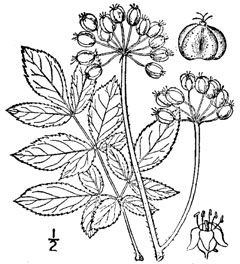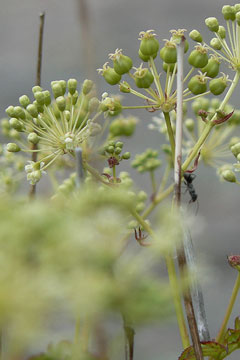 |
|
http://plants.usda.gov/ |
 |
| http://flickr.com/photos/34259482@N00 |
Translate this page:
Summary
Physical Characteristics

 Aralia hispida is a deciduous Shrub growing to 1 m (3ft 3in).
Aralia hispida is a deciduous Shrub growing to 1 m (3ft 3in).
See above for USDA hardiness. It is hardy to UK zone 3 and is not frost tender. It is in flower from May to June. The species is hermaphrodite (has both male and female organs) and is pollinated by Insects.
Suitable for: light (sandy), medium (loamy) and heavy (clay) soils, prefers well-drained soil and can grow in nutritionally poor soil. Suitable pH: mildly acid, neutral and basic (mildly alkaline) soils. It can grow in semi-shade (light woodland) or no shade. It prefers dry or moist soil.
UK Hardiness Map
US Hardiness Map
Synonyms
Plant Habitats
Woodland Garden Sunny Edge; Dappled Shade;
Edible Uses
Edible Parts:
Edible Uses: Drink Tea
A tea is made from the roots[183]. The roots are also used for making 'root beer'[183].
References More on Edible Uses
Medicinal Uses
Plants For A Future can not take any responsibility for any adverse effects from the use of plants. Always seek advice from a professional before using a plant medicinally.
Alterative Cardiac Diaphoretic Diuretic Tonic
A tea made from the leaves is diaphoretic[222]. The root is alterative and tonic[257]. An infusion of the root has been used in the treatment of heart diseases[257]. The bark, and especially the root bark, is diuretic and tonic[4, 222]. A homeopathic remedy is made from the fresh root[4]. It has alterative, diaphoretic and diuretic properties and is considered to be a good treatment for dropsy[4].
References More on Medicinal Uses
The Bookshop: Edible Plant Books
Our Latest books on Perennial Plants For Food Forests and Permaculture Gardens in paperback or digital formats.

Edible Tropical Plants
Food Forest Plants for Hotter Conditions: 250+ Plants For Tropical Food Forests & Permaculture Gardens.
More

Edible Temperate Plants
Plants for Your Food Forest: 500 Plants for Temperate Food Forests & Permaculture Gardens.
More

More Books
PFAF have eight books available in paperback and digital formats. Browse the shop for more information.
Shop Now
Other Uses
References More on Other Uses
Cultivation details
Prefers a moderately fertile deep moisture-retentive well-drained loam and a position in semi-shade but also succeeds in a sunny position[200]. Requires a sheltered position[200]. Plants are hardier when grown on poorer soils[200]. This species is especially tolerant of poor dry soils[200]. Prefers an acid soil[184]. Dormant plants are hardy to at least -15°c[184, 200]. The young growth in spring, even on mature plants, is frost-tender and so it is best to grow the plants in a position sheltered from the early morning sun[K]. The whole plant has an unpleasant smell[4]. For polyculture design as well as the above-ground architecture (form - tree, shrub etc. and size shown above) information on the habit and root pattern is also useful and given here if available. A clumping plant, forming a colony from shoots away from the crown but with a limited spread [1-2]. The root pattern is suckering with new plants from underground runners away from the plant [1-2].
References Carbon Farming Information and Carbon Sequestration Information
Temperature Converter
Type a value in the Celsius field to convert the value to Fahrenheit:
Fahrenheit:
The PFAF Bookshop
Plants For A Future have a number of books available in paperback and digital form. Book titles include Edible Plants, Edible Perennials, Edible Trees,Edible Shrubs, Woodland Gardening, and Temperate Food Forest Plants. Our new book is Food Forest Plants For Hotter Conditions (Tropical and Sub-Tropical).
Shop Now
Plant Propagation
Seed - best sown as soon as ripe in a cold frame. Stored seed requires 3 - 5 months of cold stratification. Germination usually takes place within 1 - 4 months at 20°c[134]. When large enough to handle, prick the seedlings out into individual pots and grow them on in light shade in a greenhouse for at least their first winter. Once the plants are 25cm or more tall, they can be planted out into their permanent positions, late spring or early summer being the best time to do this. Root cuttings 8cm long, December in a cold frame[11, 78]. Store the roots upside down in sand and pot up in March/April. High percentage[78]. Division of suckers in late winter[11]. Very easy, the suckers can be planted out direct into their permanent positions if required.
Other Names
If available other names are mentioned here
bristly sarsaparilla plant, bristly sarsparilla, dwarf elder, Hairy sarsaparilla.
Native Range
NORTHERN AMERICA: Canada, Québec, Nova Scotia, Ontario, Prince Edward Island, New Brunswick, Newfoundland and Labrador, Saskatchewan, Manitoba, United States, Connecticut, Indiana (north), Maine, Massachusetts, Michigan, New Hampshire, New Jersey, New York, Ohio (north), Pennsylvania, Rhode Island, Vermont, West Virginia, Illinois (northeast), Minnesota (northeast), Wisconsin, Kentucky (east),
Weed Potential
Right plant wrong place. We are currently updating this section.
Please note that a plant may be invasive in one area but may not in your area so it's worth checking.
Conservation Status
IUCN Red List of Threatened Plants Status :

| Related Plants
|
| Latin Name | Common Name | Habit | Height | Hardiness | Growth | Soil | Shade | Moisture | Edible | Medicinal | Other |
| Aralia chinensis | Chinese Angelica Tree, Pumila Spirea, Chinese Astilbe | Shrub | 3.5 |
4-8
| M | LMH | FS | M | 2 | 2 | |
| Aralia continentalis | Manchurian Spikenard | Perennial | 2.0 |
7-10
| | LMH | FS | M | 2 | 0 | |
| Aralia cordata | Udo | Perennial | 1.8 |
4-9
| | LMH | FS | M | 4 | 2 | 0 |
| Aralia elata | Japanese Angelica Tree, Angelica Tree | Tree | 6.0 |
4-9
| M | LMH | SN | M | 3 | 2 | 2 |
| Aralia mandschurica | Manchurian Angelica Tree | Shrub | 3.5 |
4-8
| | LMH | SN | M | 2 | 2 | |
| Aralia nudicaulis | Wild Sarsaparilla | Perennial | 0.4 |
4-8
| | LMH | FS | M | 4 | 3 | 3 |
| Aralia racemosa | American Spikenard | Perennial | 1.8 |
4-8
| | LMH | FS | M | 3 | 3 | 2 |
| Aralia schmidtii | Sakhalin Spikenard | Perennial | 3.0 |
4-8
| | LMH | FS | M | 2 | 0 | |
| Aralia spinosa | Hercule's Club, Aralia spinosa, American Angelica Tree, Hercules' Club, Devil's Walking Stick | Tree | 9.0 |
5-9
| S | LMH | FS | M | 2 | 2 | 2 |
| Eleutherococcus chiisanensis | | Shrub | 0.0 |
-
| | LMH | SN | M | 2 | 0 | |
| Eleutherococcus divaricatus | | Shrub | 3.5 |
5-9
| | LMH | SN | M | 2 | 0 | |
| Eleutherococcus gracylistylus | Wu Jia Pi | Shrub | 3.0 |
5-9
| | LMH | SN | M | 1 | 3 | |
| Eleutherococcus innovans | Taka-No-Tsume | Tree | 6.0 |
6-9
| | LMH | N | M | 1 | 0 | |
| Eleutherococcus japonicus | | Shrub | 3.0 |
-
| | LMH | SN | M | 1 | 0 | |
| Eleutherococcus senticosus | Siberian Ginseng | Shrub | 2.0 |
3-7
| S | LMH | SN | M | 2 | 5 | |
| Eleutherococcus seoulensis | | Shrub | 0.0 |
-
| | LMH | SN | M | 1 | 0 | |
| Eleutherococcus sessiliflorus | | Shrub | 4.5 |
4-8
| | LMH | SN | M | 2 | 3 | |
| Eleutherococcus sieboldianus | Ukogi, Five Leafed Aralia | Shrub | 3.0 |
4-8
| S | LMH | SN | M | 3 | 0 | 2 |
| Eleutherococcus spinosus | | Shrub | 3.0 |
4-8
| | LMH | SN | M | 2 | 2 | 2 |
| Eleutherococcus trifoliatus | | Shrub | 6.0 |
6-9
| | LMH | SN | M | 1 | 1 | |
| Hedera helix | Ivy, English ivy, Algerian ivy, Baltic Ivy, Common Ivy | Climber | 15.0 |
5-11
| M | LMH | FSN | MWe | 0 | 3 | 4 |
| Hedera nepalensis | Nepal Ivy | Climber | 15.0 |
7-10
| M | LMH | FSN | MWe | 0 | 2 | |
| Kalopanax sciadophylloides | | Tree | 0.0 |
-
| | LMH | SN | M | 1 | 0 | |
| Kalopanax septemlobus | Tree Aralia, Castor aralia | Tree | 25.0 |
4-8
| S | LMH | SN | M | 2 | 1 | 2 |
| Kirkophytum lyallii | | Perennial | 0.2 |
-
| | LMH | SN | M | 1 | 0 | |
| Oplopanax horridus | Devil's Club | Shrub | 2.0 |
4-8
| | LMH | FS | M | 2 | 2 | 1 |
| Panax ginseng | Ginseng, Chinese ginseng | Perennial | 0.8 |
5-9
| | LMH | FS | M | 2 | 5 | |
| Panax japonicus | Japanese Ginseng | Perennial | 0.6 |
-
| | LMH | FS | M | 1 | 1 | 1 |
| Panax pseudoginseng | Ginseng, Japanese ginseng | Perennial | 1.0 |
5-9
| S | LMH | FS | M | 1 | 3 | |
|
|
Growth: S = slow M = medium F = fast. Soil: L = light (sandy) M = medium H = heavy (clay). pH: A = acid N = neutral B = basic (alkaline). Shade: F = full shade S = semi-shade N = no shade. Moisture: D = dry M = Moist We = wet Wa = water.
Now available:
Food Forest Plants for Mediterranean Conditions
350+ Perennial Plants For Mediterranean and Drier Food Forests and Permaculture Gardens.
[Paperback and eBook]
This is the third in Plants For A Future's series of plant guides for food forests tailored to
specific climate zones. Following volumes on temperate and tropical ecosystems, this book focuses
on species suited to Mediterranean conditions—regions with hot, dry summers and cool, wet winters,
often facing the added challenge of climate change.
Read More
Expert comment
Author
Vent.
Botanical References
200204
Links / References
For a list of references used on this page please go here
Readers comment
| Add a comment |
|
If you have important information about this plant that may help other users please add a comment or link below. Only comments or links that are felt to be directly relevant to a plant will be included. If you think a comment/link or information contained on this page is inaccurate or misleading we would welcome your feedback at [email protected]. If you have questions about a plant please use the Forum on this website as we do not have the resources to answer questions ourselves.
* Please note: the comments by website users are not necessarily those held by PFAF and may give misleading or inaccurate information.
To leave a comment please Register or login here All comments need to be approved so will not appear immediately.
|
|